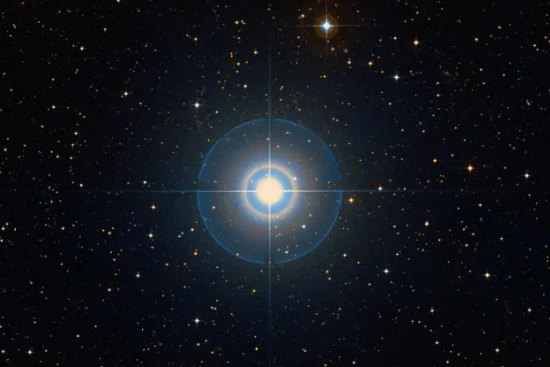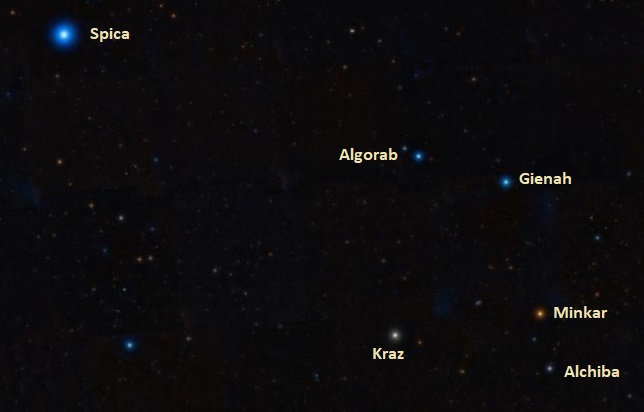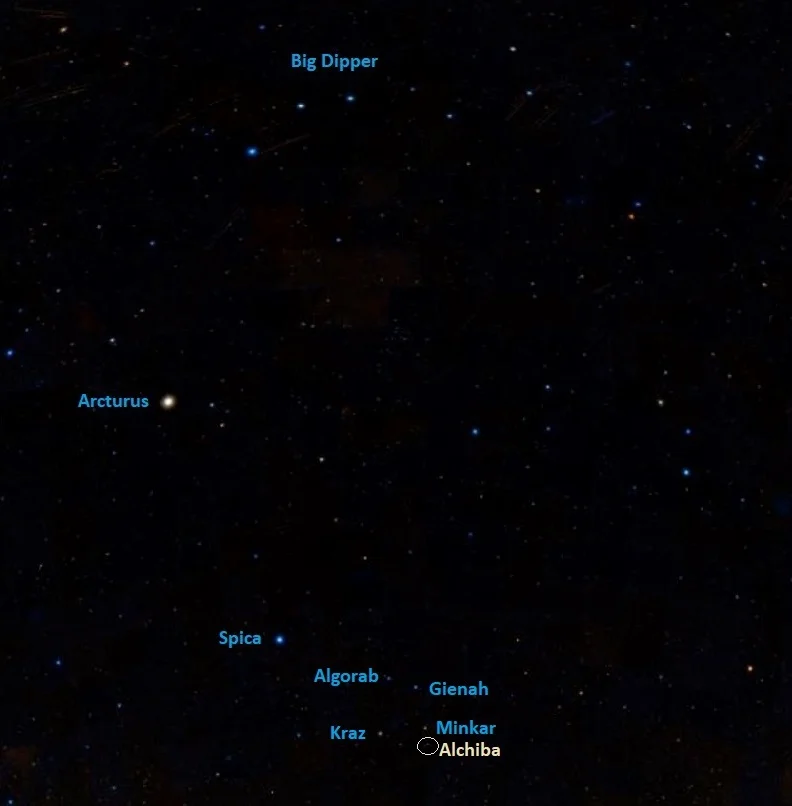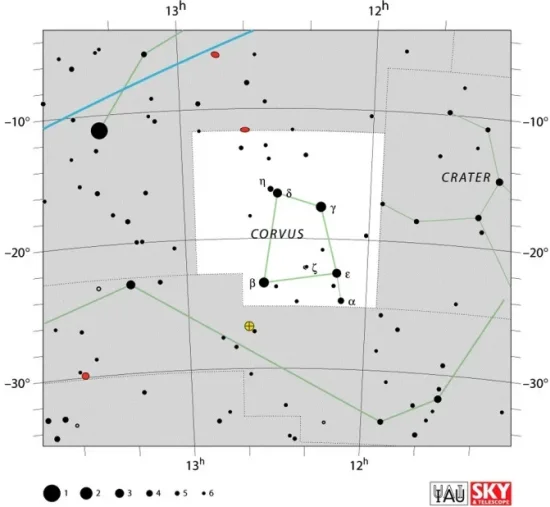Alchiba, Alpha Corvi (α Crv), is a white, class F main sequence star located in the constellation Corvus. With an apparent magnitude of 4.03, it is the fifth brightest star in Corvus, after Gienah, Kraz, Algorab, and Minkar. Alchiba lies at a distance of 48.7 light years from Earth. It can be found just south of the asterism known as Spica’s Spanker, formed by the brightest stars of Corvus.
Star type
Alchiba is a main sequence star of the spectral type F1 V. It has a mass of 1.39 solar masses and a radius of 1.60 solar radii. With a surface temperature of 7,041 K, it shines with 4.696 solar luminosities. It has a projected rotational velocity of 16.9 km/s.
In 2012, a study reported spectroscopic variations in the star over a three-day period. Spectroscopic observations initially indicated that Alchiba was a spectroscopic binary, but subsequent monitoring did not reveal a companion. The study concluded that the variations were the result of non-radial gravity-mode pulsations typical of Gamma Doradus variables. Gamma Doradus stars typically show brightness variations of 0.1 magnitudes over a period of about a day.

Alchiba (Alpha Corvi), image: Wikisky
The same study suggested that Alchiba was a member of the Ursa Major association, a group of young stars that includes most of the bright stars of Ursa Major, that were formed in the same molecular cloud and travel together through space.
Facts
Alchiba has the Bayer designation Alpha Corvi even though it is only the fifth brightest star in Corvus. It is outshone by Gienah (Gamma Corvi), Kraz (Beta Corvi), Algorab (Delta Corvi) and Minkar (Epsilon Corvi). It has been suggested that Alchiba may have been brighter in the 17th century, when German astronomer Johann Bayer assigned the Greek letter designations to stars. It is also possible that the star changed in colour in the last millennium, since the 10th century Persian astronomer Al Sufi referred to it as red.
Today, Alchiba is one of the faintest Alpha stars in the sky, along with Alpha Octantis (mag. 5.13), Alpha Mensae (mag. 5.09), Alpha Microscopii (mag. 4.89), Alpha Sextantis (mag. 4.49), Alpha Sculptoris (mag. 4.30), Diadem (Alpha Comae Berenices, mag. 4.85), Alpha Chamaeleontis (mag. 4.06), Alpha Antliae (mag. 4.25), and the nearby Alkes (Alpha Crateris, mag. 4.07).
Name
The name Alchiba (pronunciation: /ˈælkɪbə/) is derived from the Arabic al-xibā, meaning “the tent.” It refers to the quadrilateral figure that dominates the constellation Corvus, which was associated with a tent in Arabic astronomy. In western astronomy, the asterism is known as Spica’s Spanker or the Sail. Alchiba is not part of the asterism but lies directly below it.

Spica’s Spanker, image: Wikisky
The name was approved by the International Astronomical Union’s (IAU) Working Group on Star Names (WGSN) on September 12, 2016. It has also been spelled Al-Khiba, Alchibah and Alchita.
Alpha Corvi has also traditionally been known as Al Minliar al Ghurab or Minkar al Ghurab, from the Arabic al-manxar al-ghurab, meaning “the beak of the crow.” The name Minkar al Ghurab appeared in Egyptian astronomer Al Achsasi al Mouakket’s Calendarium, written around 1650. It was translated into Latin as Rostrum Corvi, “the beak of the crow.”
The name Minkar has also traditionally been used for the nearby Epsilon Corvi, but it has not been formally approved for either star.
The Chinese know Alchiba as 右轄 (Yòuxiá), or Right Linchpin. In Chinese astronomy, it is the only star in the Right Linchpin asterism. The asterism is part of the Chariot mansion, one of the southern mansions of the Vermilion Bird.
Location
Alchiba is easy to find because it lies near Spica, the 16th brightest star in the sky, and just south of the star pattern known as Spica’s Spanker. Spica is found along the imaginary curved line drawn from the three stars of the Big Dipper’s handle, Alioth, Mizar and Alkaid. Arcturus, the brightest star in the constellation Boötes, is the first star on this line and Spica is the second.

Alchiba location, image: Wikisky
Spica’s Spanker, formed by Gienah, Kraz, Algorab and Minkar, lies just southwest of Spica. Alchiba is located south of Gienah and Minkar.
Constellation
Alchiba is located in the constellation Corvus. Representing the celestial crow, the sacred bird of Apollo, Corvus is one of the 48 Greek constellations, first listed by the astronomer Claudius Ptolemy of Alexandria in the 2nd century CE.
Corvus is the 70th constellation in size (out of 88), occupying 184 square degrees of the southern sky between the larger Hydra, Virgo, and Crater. It contains three stars brighter than magnitude 3.00: Gienah, Kraz, and Algorab. Even though the constellation is not particularly bright, it is easily recognized because its four brightest stars form a distinct asterism, Spica’s Spanker.

Corvus constellation map by IAU and Sky&Telescope magazine
Corvus contains several relatively bright deep sky objects. These include the planetary nebula NGC 4361, located near the centre of Spica’s Spanker, and the famous interacting galaxies NGC 4038 and NGC 4039, also known as the Antennae Galaxies. The Antennae show a likely future of the Milky Way and Andromeda galaxies when they begin to merge. They are at the centre of the NGC 4038 Group, which also includes the spiral galaxies NGC 4027 and NGC 3981, the elliptical galaxy NGC 4033, and at least a dozen other members.
Interesting stars in Corvus include the blue giant Gienah, the constellation’s brightest star, the orange giant Minkar, the yellow bright giant Kraz, and the eclipsing binary systems SX Corvi and VV Corvi.
The best time of year to observe the stars and deep sky objects of Corvus is during the month of May, when the constellation climbs high above the horizon in the evening. The entire constellation is visible from locations between the latitudes 60° N and 90° S.
The 10 brightest stars in Corvus are Gienah (Gamma Crv, mag. 2.585), Kraz (Beta Crv, mag. 2.647), Algorab (Delta Crv, mag. 2.962), Epsilon Corvi (mag. 3.024), Alchiba (Alpha Crv, mag. 4.03), Eta Corvi (mag. 4.29 – 4.32), HD 107418 (mag. 5.14), VV Corvi (mag. 5.19 – 5-34), TY Corvi (31 Crt, mag. 5.19 – 5.23), and Zeta Corvi (mag. 5.21).
Alchiba – Alpha Corvi
| Spectral class | F1 V |
| Variable type | Gamma Doradus (suspected) |
| U-B colour index | +0.00 |
| B-V colour index | +0.34 |
| Apparent magnitude | 4.03 |
| Absolute magnitude | 3.25 |
| Distance | 48.7 ± 0.1 light years (14.94 ± 0.03 parsecs) |
| Parallax | 66.95 ± 0.15 mas |
| Radial velocity | +2.80 ± 0.3 km/s |
| Proper motion | RA: 99.52 ± 0.15 mas/yr |
| Dec.: -39.19 ± 0.10 mas/yr | |
| Mass | 1.39 M☉ |
| Luminosity | 4.696 L☉ |
| Radius | 1.60 R☉ |
| Temperature | 7,041 ± 53 K |
| Metallicity | −0.19 ± 0.04 dex |
| Rotational velocity | 16.9 ± 1.5 km/s |
| Surface gravity | 4.13 ± 0.05 cgs |
| Constellation | Corvus |
| Right ascension | 12h 08m 24.8165241s |
| Declination | −24° 43′ 43.950354″ |
| Names and designations | Alchiba, Al Minliar al Ghurab, Alpha Corvi, α Crv, 1 Corvi, HD 105452, HR 4623, HIP 59199, SAO 180505, GC 16586, GCRV 7276, PPM 259912, GJ 455.3, CD −24° 10174, CPD-24 4786, PLX 2796.00, JP11 2172, UBV 10894, IRAS 12058-2426, 2MASS J12082481-2443440, TYC 6672-995-1, Gaia DR2 3489338019474978176 |